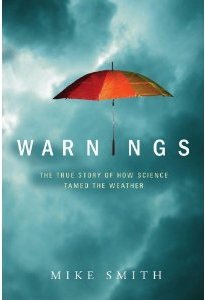Book Review: Mike Smith’s New Book

Warnings: The True Story of How Science Tamed the Weather by Mike Smith
Mike Smith was the Guest WeatherBrain on episode 199 last November. Listen here.
Do you remember the last time that a tornado killed one hundred or more people? Do you remember the last time that a U.S. passenger jet crashed because of a microburst? Probably not, because these events have not happened in a long time. Weather entrepreneur Mike Smith tells us why most of us can’t remember than far back in his recently released book Warnings: The True Story of How Science Tamed the Weather.
Too often we hear the media say that a storm struck “without warning”. But in reality, that hardly ever occurs. Te probability that a significant event will be warned for is approaching 100%. People have ample warning about most storms now. The issue is whether they receive the warnings, understand them and take appropriate action. That was not the case on April 9, 1947. The people in the destroyed town of Woodward, Oklahoma never knew what hit them, even though the storm that produced the massive tornado had been noted over an hour earlier by an FAA weather observer. It was no one’s job to warn the people ahead of the storm.
A year later, the military had enough of surprise tornadoes. But it took a miracle event in Oklahoma City to prove that the destructive storms could be forecast. It took three more years and numerous fatalities to convince the bureaucrats at the U.S. Weather Bureau to bring warnings to the public. Even then, the town of Udall, Kansas died in its sleep at 10:35 p.m. on May 25, 1955.
But a steady stream of improvements over the decades in the weather enterprise led to a May night in 2008 when a tiny Kansas prairie town lay in the path of another massive twister. But this time, powerful Doppler radars tracked the storm’s every move. Forecasts were accurate hours and days in advance. Warning systems worked flawlessly. Even though most of the town of Greensburg was obliterated, the death toll was extremely low.
When is the last time you heard of a hurricane killing 1,000 people? Oh, yeah. Katrina. But the author argues that Katrina was murder by bureaucracy. It still takes more than a perfect forecast to prevent loss of life. Think Hurricane Ike.
It is easy to focus on the mistakes that are made in the warning process. It is still an imperfect science. But Smith shows us that the progress that has been made in reducing fatalities from severe weather has surpassed that of curing cancer, preventing heart disease deaths and reducing automobile death rates. So next time you hear about a massive tornado or landfalling hurricane. Consider what the death toll would have been fifty years ago. And thank a meteorologist.
Follow my weather history tweets. I am wxhistorian @ twitter.com
Category: Pre-November 2010 Posts















